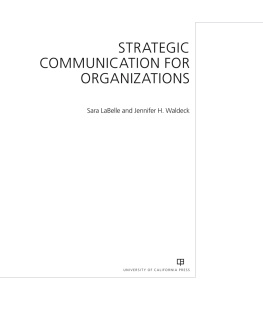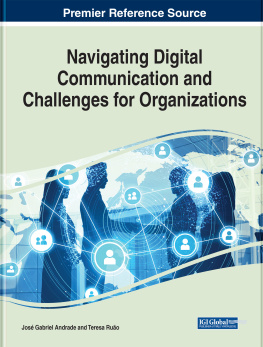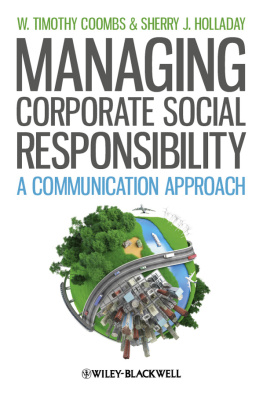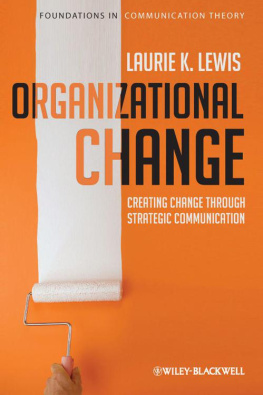Acknowledgments
Strategic Communication for Organizations would not have been possible without the talented team at the University of California Press. Lyn Uhl, our executive editor, has been a tremendous source of support from our first discussions of writing a communication-centric textbook on the strategic communication campaign process. Her experience in the publishing industry and enthusiasm for this project encouraged us throughout the long process of bringing the book to fruition. She sought out the best possible willing and available reviewers and provided expert insight that assisted us in using those reviews to make the book better. We extend to her a great deal of appreciation for her continued support of this project.
Lisa Moore was a tremendous gift to us in her role as developmental editor. Her kind and constructive feedback was instrumental in the early phases of our writing process, and her comments and suggestions on the near-final versions of our chapters undoubtedly increased the value of this text. Some books are easier to conceptualize, organize, and write than others. This project was a challenge from the start, because it truly is the first of its kind. There were no competitors to assess and either model or seek to improve on. Working from a blank slate allows for innovation but requires focus and, often, an outside perspective on something that the authors are so intertwined with. Lisa provided both with professionalism and constant concern for student needs. Her suggestions helped us to articulate our ideas and clarify our thinking. Strategic Communication for Organizations is better for her thoughtful, constructive, and insightful feedback.
We would also like to thank Enrique Ochoa-Kaup, who answered endless emails about the book preparation process with a kind and helpful attitude. We have appreciated you immensely. We are grateful to the production editors, graphic designers, and other technicians who made this book come alive beautifully. Thank you to Chris Jolly for doing the hard work of producing an instructors manualwe are so grateful to have this accompany our text, and we know it will be of tremendous use to the instructors who adopt it. To all of those who work behind the scenes at the University of California Pressthank you for helping our vision become a reality.
A number of talented and insightful colleagues at various institutions gave generously of their time and wisdom in reviewing each and every chapter of this book. They challenged us, encouraged us, and provided their insights on a very interdisciplinary processwhich in turn helped us to write a better book. Thank you to Katherine S. Thweatt (Oswego State University of New York), Janie Harden Fritz (Duquesne University), Patrice Buzzanell (University of South Florida), Scott W. Dunn (Radford University), Brad Van Alstyne (Dominican University of California), Joshua B. Barbour (The University of Texas at Austin), and Matthew Weber (University of Minnesota).
We would like to thank our students and colleagues in the School of Communication at Chapman University for their support. Dr. Lisa Sparks, dean of the School of Communication, provided unconditional support for this project and believed deeply in its value. Her enthusiasm for a book of this nature was contagious and kept us focused and excited about our work.
To all of our colleagues and friends at Chapman, we appreciate your collegiality and support.
To our undergraduate students in strategic and corporate communication, a special thank you for inspiring the content and form of this workwe had you in mind when writing our chapters and creating content that would be interesting and applicable to you. Jennifers graduate students in organizational communication and communication consulting provided functional support when they read unpublished drafts of several chapters. Their feedback and support for the value of a book on this topic were both helpful and encouraging.
Finally, it would have been nearly impossible to accomplish this endeavor without the loving support of friends and family. Your advice, mentorship, and friendship are not forgotten in acknowledging who has helped us achieve this goal. Sara would like to thank in particular Dr. Melissa Wanzer and Dr. Keith WeberI doubt I will ever be able to express my gratitude for all that you have done for me, and for always ensuring that I have educators to aspire to be like. To my parents Tom and Carol LaBellethank you for always hearing me out, even when you do not entirely understand why I am stressed! To Nicole, for always being a model of what friendship entails. To Zac, who is the only other person who has listened to every thought, been a soundboard for every brainstorming session, who has heard every idea in every chapter of this book and provided insight, support, and advice along the wayno amount of thanks would ever be sufficient. Finally, to my coauthor Jennifer, you presented me with an opportunity that challenged me, that helped me grow, that gave me confidence, and that resulted in one heck of a book. Thank you.
Jennifer would like to thank dear friends and mentors Patricia Kearney, Tim Plax, Dave Seibold, Paul Nelson, and Judy Pearson. They taught me how to write about complex and sophisticated ideas in a fashion that undergraduate students and laypeople will learn something from. They also instilled in me the importance of mentoring and encouraging promising colleagues. Thank you to the most promising of all of them, Dr. Sara LaBelle, my coauthor, for giving me the opportunity to do just that.
Founded in 1893,
UNIVERSITY OF CALIFORNIA PRESS
publishes bold, progressive books and journals on topics in the arts, humanities, social sciences, and natural scienceswith a focus on social justice issuesthat inspire thought and action among readers worldwide.
The UC PRESS FOUNDATION
raises funds to uphold the presss vital role as an independent, nonprofit publisher, and receives philanthropic support from a wide range of individuals and institutionsand from committed readers like you. To learn more, visit ucpress.edu/supportus.
CHAPTER 1
An Introduction to Strategic Communication
CHAPTER CONTENTS
1.1
1.2
1.2.1
1.2.2
1.2.3
1.2.4
1.3
1.3.1
1.3.2
1.3.3
1.3.4
1.4
LEARNING OBJECTIVES
After reading this chapter, you should be able to do the following:
 Distinguish between strategic communication and communication more broadly.
Distinguish between strategic communication and communication more broadly.
 Explain why strategic communication is important in organizations.
Explain why strategic communication is important in organizations.
 Identify common issues that both new and established organizations face in their internal and external communication efforts.
Identify common issues that both new and established organizations face in their internal and external communication efforts.
 Compare and contrast the linear and simultaneous transactions models of communication.
Compare and contrast the linear and simultaneous transactions models of communication.
 Recall the four foundational assumptions of a strategic approach to communication.
Recall the four foundational assumptions of a strategic approach to communication.
Jacob is a recent college graduate. Armed with a degree in business and a passion for entrepreneurship, Jacob has developed an environmentally friendly home cleaning product, EcoCleanR. He is thrilled to finally pursue his passion by founding his own start-up company to manufacture and distribute the cleaner. At first, things are going great: Jacob has a small team of talented college friends who are helping him with design and manufacturing, and his family and friends are happy to help buy EcoCleanR and talk about it in their own social networks. After a few months, though, the excitement and energy levels are waning for Jacob and his smalland burned outstaff. Sales are also dropping; the friends and family that initially bought and used EcoCleanR are still supportive, but Jacob needs to reach new audiences if he wants to continue to sell this product. What makes matters worse is that a large manufacturer has just announced a new sustainability initiative and launched products that have similar ingredient profiles to EcoCleanR. The pressure of this announcement is causing stress on his staff, who are not sure how Jacobs product is unique or better than the competition.











 Distinguish between strategic communication and communication more broadly.
Distinguish between strategic communication and communication more broadly.